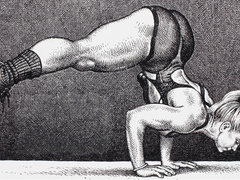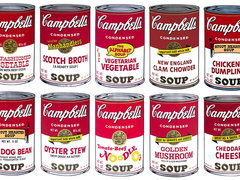The Online Art Market Is Booming—Here’s What You Need to Know
On Tuesday, art insurance company Hiscox released its fourth annual report detailing the state of the online art trade. Their findings, which examine data gathered by art market research firm ArtTactic, confirm indications in last month’s TEFAF report that the cooling of the global art market has not yet affected online sales—on the contrary, they are at an all-time high. Below are five takeaways from the 2016 report.

Online sales jumped 24% last year, to a high of $3.27 billion.
Fueled by the expansion of a number of online platforms, the online art market has grown from $1.57 billion in 2013, to $2.62 billion in 2014, to last year’s figure of $3.27 billion. Such growth prompted Hiscox to revise its forecast for the sector up 5%, from the 19% found in previous editions of the report to 24% this year. If growth continues at this rate, the online art market will be worth around $9.58 billion by the end of the decade. The report notes that their growth outlook of 24% for the online art market is in line with the general online luxury goods sector, which has grown 27% year over year from 2009 to 2014. Due to the fact that Hiscox’s numbers are based off publicly available sales info and estimates of the “main online art and collectible sales platforms” they are assumed to be a conservative indication of growth. Also not counted is the entirety of the online art market in China.
The growth comes amid a market that is variously seen as either uncertain or cooling. Given that the online art market is comprised primarily of works on the lower end of the price spectrum, selling for less than $10,000, it may be more resilient to a general downturn or even positively impacted as buyers become more attuned to their spending during a contraction.
Online art market buyers are likely to return, with 92% saying they would buy the same amount of—or more—work online in the next 12 months.
Of those surveyed, 48% of art buyers said they would be buying more art and collectibles online in the next 12 months, while 44% said they would buy the same amount and 8% said they would buy less (a drop of 6% from last report’s 14%). Four percent fewer people said they would purchase more art online this year than they did in 2015. But this didn’t amount to an exodus from the market, with a 10% year over year increase being tallied among those responding that they would purchase the same amount of art online. The amount of new art buyers in the online market lessened slightly (from 43% to 41%), indicating that current buyers will make up a larger chunk of the 92%. Complicating matters, however, is the fact that, as the report notes, “the majority of existing art buyers see the online art market as an alternative channel for acquiring art rather than a substitute and therefore an overall slowdown in sales is likely to also have an impact on the online art market for these type of buyers.”
Of the 672 art buyers surveyed (up from 519 last year), only 10% (or 67 people) reported spending more than £100,000 on art and collectibles in 2015 and 5% reported spending between £50,000 and £100,000. The vast majority of online art buyers have relatively small budgets, with 69% spending less than £10,000 per year, and roughly half of that number spending less than £1,000. Hiscox suggests that this distribution is a positive indicator for the online art sector’s long term health: Growth in the online art market may in fact be coming from new buyers, unknown to those conducting the study, who are making small purchases.
Although all online platforms have seen an increase in the number of buyers active on their sites in the past year, the largest boost was in the realm of “online art marketplaces.” Compared to 21% in 2015, 41% of this year’s respondents had purchased art from online marketplaces. These platforms are even more popular among buyers between the ages of 18 and 35, where just over half of respondents are purchasing art through online marketplaces. This marks the first time online marketplaces have surpassed online auctions in popularity, albeit only slightly—37% of buyers surveyed for the 2016 report had purchased art via auction. These numbers seem to indicate a growing preference for “buy now” options, as opposed to timed or live auctions. Online auction aggregator Invaluable acknowledged the shift early last month by introducing a fixed-price alternative on their website; traditional auctioneers Christie’s and Bukowski’s already sell a portion of their works online for a set price.
There’s been a shift in the way we surf the web—just last month, people in the U.S. spent more than a trillion minutes online with mobile devices, close to double the amount of time they spent on desktop computers. This trend is reflected in the Hiscox report, which demonstrates a growing reliance on smartphones and other devices to access online art platforms. On average, 40% of visitor traffic and 24% of bids and transactions came through mobile, according to data collected from 9 online art sellers. Although the level of mobile traffic appears relatively consistent between companies, mobile sales vary significantly. Artfinder is the most mobile-oriented of the companies surveyed, with a notable 43% of bids and transactions taking place via mobile. Artsy and Paddle8 fall above average, at 30%; Artspace and Invaluable, however, sell only about 15% of their works via mobile.
Online marketplaces are eclipsing online auctions as the favored method of purchasing art, indicating that buyers appear increasingly interested in fixed-price options.
Although all online platforms have seen an increase in the number of buyers active on their sites in the past year, the largest boost was in the realm of “online art marketplaces.” Compared to 21% in 2015, 41% of this year’s respondents had purchased art from online marketplaces. These platforms are even more popular among buyers between the ages of 18 and 35, where just over half of respondents are purchasing art through online marketplaces. This marks the first time online marketplaces have surpassed online auctions in popularity, albeit only slightly—37% of buyers surveyed for the 2016 report had purchased art via auction. These numbers seem to indicate a growing preference for “buy now” options, as opposed to timed or live auctions. Online auction aggregator Invaluable acknowledged the shift early last month by introducing a fixed-price alternative on their website; traditional auctioneers Christie’s and Bukowski’s already sell a portion of their works online for a set price.
Online art sales are joining the migration from desktop to mobile.
There’s been a shift in the way we surf the web—just last month, people in the U.S. spent more than a trillion minutes online with mobile devices, close to double the amount of time they spent on desktop computers. This trend is reflected in the Hiscox report, which demonstrates a growing reliance on smartphones and other devices to access online art platforms. On average, 40% of visitor traffic and 24% of bids and transactions came through mobile, according to data collected from 9 online art sellers. Although the level of mobile traffic appears relatively consistent between companies, mobile sales vary significantly. Artfinder is the most mobile-oriented of the companies surveyed, with a notable 43% of bids and transactions taking place via mobile. Artsy and Paddle8 fall above average, at 30%; Artspace and Invaluable, however, sell only about 15% of their works via mobile.
On average, this data matches up with the report’s survey of art buyers. 81% say they purchase artwork using a laptop or PC, with the other 19% using a tablet and 13% using a mobile device. Interestingly, this number remains consistent even when looking at younger art buyers—82% of 18- to 35-year-olds purchase art from a desktop computer. These figures represent an increase from last year, when only 68% of respondents said they used a desktop to buy art online. It appears as though mobile offers an outlet for browsing, but when it comes time to make a purchase, buyers tend to return to their PC.
Besides highlighting the important growth that will come from this age group, Hiscox notes some interesting things about habits of the Gen Y cohort. For one thing, they’re emotional—92% citing some kind of feeling as a motivating factor to buy art. They haven’t entirely escaped being bitten by the finance bug, of course, with 57% also citing “investment” as a purchasing reason, followed by “identity/status” (44%) and then “social” (39%). They also tend to gravitate towards fine art, with 81% responding that they buy art online. The next closest category is “decorative art and design,” at 61%.
Of this technology-savvy generation, 46% of those surveyed said that they purchase art online. However, an equal 46% among those said that they prefer offline transactions (40% said they have no preference and 14% prefer purchasing art online). Gen Y individuals who do purchase art online are likely to buy more than once, with 49% purchasing between 2 and 5 works in the last 12 months and 68% saying they’re looking to buy more in the next 12.
—Abigail Cain and Isaac Kaplan
Among Generation Y buyers—also known as millennials—19% made their first-ever purchase online, up from 9% last year.
Besides highlighting the important growth that will come from this age group, Hiscox notes some interesting things about habits of the Gen Y cohort. For one thing, they’re emotional—92% citing some kind of feeling as a motivating factor to buy art. They haven’t entirely escaped being bitten by the finance bug, of course, with 57% also citing “investment” as a purchasing reason, followed by “identity/status” (44%) and then “social” (39%). They also tend to gravitate towards fine art, with 81% responding that they buy art online. The next closest category is “decorative art and design,” at 61%.
Of this technology-savvy generation, 46% of those surveyed said that they purchase art online. However, an equal 46% among those said that they prefer offline transactions (40% said they have no preference and 14% prefer purchasing art online). Gen Y individuals who do purchase art online are likely to buy more than once, with 49% purchasing between 2 and 5 works in the last 12 months and 68% saying they’re looking to buy more in the next 12.
—Abigail Cain and Isaac Kaplan

 30 Emerging Artists to Watch This Spring
30 Emerging Artists to Watch This Spring R. Crumb Delivers Comic Relief to a Beauty-Obsessed Society
R. Crumb Delivers Comic Relief to a Beauty-Obsessed Society Warhol Soup Can Prints Stolen—and the 9 Other Biggest News Stories This Week
Warhol Soup Can Prints Stolen—and the 9 Other Biggest News Stories This Week
No comments:
Post a Comment